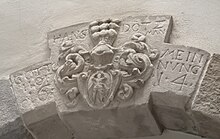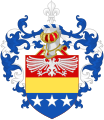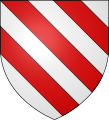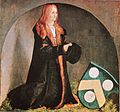Burgher arms


Burgher armsorbourgeois armsarecoats of armsborne by persons of theburghersocial class ofEuropesince theMiddle Ages(usually calledbourgeoisin English). By definition, however, the term is alien toBritish heraldry,which follows other rules.
In some European countries, certain armorial bearings have traditionally been restricted to a particular social class (usually thenobility), e.g. the use ofsupportersinGreat Britain,tincturesinPortugalorcoronetsinSweden.Notwithstanding, in most countries outside theUnited Kingdom,any individual, family and community has usually been free to adopt arms and use them as they please, provided they refrain from wrongfully assuming the preexisting arms of another.[1]In addition to thebourgeoisie,peasantssometimes made use of this tradition.[citation needed]Arms of theclergyare classified asecclesiastical heraldry.
Use of coats of arms by burghers andartisansbegan during the 13th century and in the 14th century some peasants took to using arms.[2]The arms of burghers bore a far wider variety ofchargesthan the arms ofnobilitylike everyday objects, and particularlytools.House marksare another type charges usually only used in burgher arms. Most widespread burgher heraldry was and still is found inBelgium,Germany,Switzerlandand in theNetherlands.In the latter only a small percentage of the existing arms belong to the nobility.[3]
Crest-coronetsin burgher arms are correct only if the arms were granted by asovereignand the coronet is explicitly mentioned in the grant.[4]
By country[edit]
Belgium[edit]
Bourgeois arms, such as those of thebourgeois of Brussels,were, and remain, common in Belgium and were granted except during theFrench Revolutionaryperiod and subsequentrepublic.
Men admitted to theSeven Noble Houses of Brussels,many of whom werenotnoble, members of theGuilds of Brussels,and of theBrussels Bourgeoisie,were also granted or assumed arms.
Today, theCouncil of Heraldry and Vexillologyfor theFrench Communityand theFlemish Heraldic Councilfor theFlemish Communitygrant ahelmwith torse,crest,andmantlingas well as amottoas external ornaments of theshield.The additaments reserved for the nobility, such as crowned helmets and rankcrowns,supportersand supports,bannersandbattle cries,mantles and pavilions, are prohibited.[5]
Examples of Belgian bourgeois arms:
-
Arms of the de Keghel family,Bourgeois of Brusselsuntil the 16th century.
-
Arms of thePipenpoy family,an oldPatricianfamily of Brussels.
-
Arms of the Dewandre family, originally fromLiège.
-
Arms of thePoelaert family,bourgeois of Brussels.
-
Arms of theVan der Meulen family
France[edit]
ancient French bourgeoisie[fr] arms used to be common inFrance,but they disappeared in theFrench Revolution,which was hostile to heraldry. In the end of the 17th century, an attempt was made to list all arms inArmorial généralas a device to increase tax revenue. When the attempt failed, in order to force people to pay tax, arms were given to many burghers who had never had them. These arms were never used by their recipients.[6]In France burgher arms are not supposed to have a helmet.
Examples of French bourgeois arms:
-
Arms of theMartinotfamily, famous clockmaker family of Paris.
-
Arms of the Thouéry family, an old bourgeois family fromMoyrazès.
-
Coat of arms of theBordes family.
Germany[edit]
Although assumption of arms always remained free, the emperors of theHoly Roman EmpiresinceCharles IVbegan to grant arms without raising people to nobiliary status. In the 15th century the authority to grant arms was delegated to “Counts Palatine of the Imperial Court”(German:Hofpfalzgrafen), who from then on also granted arms to burghers. This was regarded as luxury everyone was not able to afford.
Thetilting helmetwas prescribed for arms of non-nobles, while the barred helmet was restricted by the imperial chancellery to the nobility as upholders of the tradition of tourneying. This privilege was also shared by certain people who enjoyed the same standing as the nobility, e.g. those who had a doctor's title in law or theology.[8] Custom of the use of the barred helmet was also followed by citypatricians.[9]Although the rule of the use of the tilting helmet by burghers was not always obeyed, it has still become the norm in many countries of theGerman-Nordic heraldic tradition,e.g. inSwedish heraldry.
After the fall of theHoly Roman Empire,arms were no longer granted to burghers except in theKingdom of Saxony,where such grants continued from 1911 until 1918.[citation needed]Elsewhere burgher arms were assumed. Such family heraldry is still alive in Germany and burgher armsare protected by law.
Examples of German burgher arms:
-
Canting armsof the German painterAlbrecht Dürer(1471–1528)
Portugal[edit]
Burgher arms had a complicated and suppressed history in Portugal. During the reign of KingAfonso V,burgher arms were restricted to the use of colours only. This restriction would become irrelevant when KingManuel Iforbade the use of arms to those who were not of thePortuguese nobility.[10]This restriction against burgher arms in Portugal lasted until the establishment of the Republic in 1910.
Arms of peasants[edit]
In some regions (Normandy,Flanders) even peasants sometimes bore arms.[11] InSwitzerland14th century arms of farmers are known, but they are rare and did not become numerous until the 17th century,[12]as well as inLower Saxony,FrisiaandTyrol,where farmers had personal freedom.[9]InDenmarkarms of farmers are preserved on seals from about 1300.[13]InNorwaypeasants have used arms since the Middle Ages and some of the arms have even been used as family arms.[14]
See also[edit]
References[edit]
- ^Pastoureau, Michel(1997).Heraldry: Its Origins and Meaning.'New Horizons' series. Translated by Garvie, Francisca. London: Thames & Hudson. p. 14.ISBN0-500-30074-7.
- ^Carl-Alexander von Volborth.Heraldry: Customs, Rules, and Styles. (Blandford Press, Dorset: 1981), p. 96
- ^Carl-Alexander von Volborth.Heraldry: Customs, Rules, and Styles. (Blandford Press, Dorset: 1981), p. 106
- ^Carl-Alexander von Volborth.The Art of Heraldry. Tiger Books International, London. 1991, p. 59ISBN1-85501-154-9
- ^"Héraldique en Belgique | Association Royale Office Généalogique et Héraldique de Belgique".oghb.be.Retrieved2019-11-30.
- ^Michel Pastoureau,Heraldry: its origins and meaning (Thames & Hudson 1997), p. 33-36
- ^Charles d'Hozier,Armorial général de France. Provence, Grasse,vol. 29,(read online).
- ^Ottfried Neubecker:A Guide to Heraldry. Cassell, London 1981, p.161.ISBN0-304-30751-3
- ^abHandbuch der Heraldik: Wappenfibel.(19th expanded edition). Edited by Ludwig Biewer. (Degener & Co, Neustadt an der Aisch 1998), p. 173
- ^Stephen Slater:The Complete Book of Heraldry.Lorenz Books 2002, p. 204
- ^Michel Pastoureau,Heraldry: its origins and meaning (Thames & Hudson 1997), p. 20
- ^Carl-Alexander von Volborth.Heraldry: Customs, Rules, and Styles. (Blandford Press, Dorset: 1981), p. 108
- ^Carl-Alexander von Volborth.Heraldry: Customs, Rules, and Styles. (Blandford Press, Dorset: 1981), p. 112
- ^Hans Krag:Norsk heraldisk mønstring fra Frederik IV's regjeringstid 1699–1730,Bind II Bønder (1942–1955) and Allan Tønnesen (ed.):Magtens besegling. Enevoldsarveregeringsakterne af 1661 og 1662 underskrevet og beseglet af stænderne i Danmark, Norge, Island og Færøerne,Odense 2013.
External links[edit]
- Right to Bear Armsfrom François Velde's Heraldica website
- Registro araldico italiano










![d'Anglemont de Tassigny [fr]](https://upload.wikimedia.org/wikipedia/commons/thumb/c/c2/Blason_de_la_famille_d%27Anglemont_de_Tassigny.svg/108px-Blason_de_la_famille_d%27Anglemont_de_Tassigny.svg.png)
![Bacot family [fr]](https://upload.wikimedia.org/wikipedia/commons/thumb/5/55/Blason_Famille_fr_Bacot.png/109px-Blason_Famille_fr_Bacot.png)
![Barazer de Lannurien [fr]](https://upload.wikimedia.org/wikipedia/commons/thumb/8/84/Blason_de_la_famille_Barazer_de_Lannurien.svg/109px-Blason_de_la_famille_Barazer_de_Lannurien.svg.png)
![Coat of arms of the Courmes family, Armorial général 1696[7]](https://upload.wikimedia.org/wikipedia/commons/thumb/1/1c/Courmes_Arms.svg/109px-Courmes_Arms.svg.png)

